The rules for Coast Guard-approved fire extinguishers have changed. Have you kept up?
Federal laws enforced by the US Coast Guard (USCG) require almost all motorized boats to have portable fire extinguishers on board. But what kind of fire extinguisher is needed? And how many?
Complying with Coast Guard rules for fire extinguishers can feel difficult because the law has changed in recent years, and with it, the vocabulary used to talk about fire extinguishers. Many sources online still cite outdated regulations. And some retailers advertise their fire extinguishers using old and new terminology.
The US Code of Federal Regulations (CFR) is the law the Coast Guard enforces. In 2016, two changes were made in the CFR to the rules for fire extinguishers on boats. First, the 2010 edition of NFPA 10: Standard for Portable Fire Extinguishers was adopted.
Second, UL nomenclature and standards for portable fire extinguishers were adopted. UL, formally known as Underwriters Laboratories, is an international safety organization recognized as an OSHA Nationally Recognized Testing Laboratory.
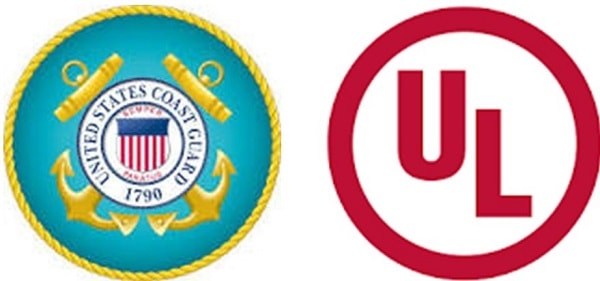
In this article, we clear up all your questions about USCG rules for fire extinguishers on boats—directly citing federal law, so there’s no doubt what the regulations are. We break down:
- When a boat needs fire extinguishers, and when it doesn’t
- What types of fire extinguishers are Coast Guard-approved
- How many fire extinguishers you need (and how big they should be)
- The basics of inspection and maintenance for fire extinguishers on boats
Primarily, we focus on smaller boats used for recreation, but there is also information about rules for larger vessels.
Fire safety is serious business, including on the water. For your maritime fire extinguisher needs, choose QRFS. We have UL-listed, Coast Guard-approved ABC fire extinguishers, plus mounting brackets, cabinets, and decals.
When are boat fire extinguishers needed?
The laws for fire extinguishers on boats are all about motors and fuels. CFR 46§25.30 lists the specific requirements for fire suppression capabilities on motorboats and motor vessels (distinguished mainly by size). Basically, any motorized boats must have at least one fire extinguisher because their fuel creates a fire hazard.
Specifically, a motorboat needs fire extinguishers if it meets any one of the following conditions (CFR 46§25.30-20), having:
- Closed compartment under thwarts and seats wherein portable fuel tanks may be stored
- Double bottoms not sealed to the hull or which are not completely filled with flotation material
- Closed living spaces
- Closed stowage compartments in which combustible or flammable materials are stowed
- Permanently installed fuel tanks
The law’s intent is not to penalize boat owners for having bait wells, glove compartments, buoyant flotation material, open slatted flooring, or ice chests. These features do not necessitate fire extinguishers and are expressly excluded from these requirements.
As you can see, a fire extinguisher should be installed on many motorized boats. Some boats, however, don’t need fire extinguishers, at least by law. Let’s look at exceptions to these rules.
Exceptions—when you aren’t required to have them
Two exceptions exist to the fire extinguisher rule. The first is for boats with low fire hazards. A boat does not need to carry extinguishers if all of the following are true (CFR 46§25.30-20):
- The boat is less than 26 feet in length
- It is propelled by outboard motors
- It is not used to carry passengers for hire
- The boat’s construction does not permit the entrapment of explosive or flammable gases or vapors
Note that the second exception is for boats with permanent fire suppression systems. When a boat less than 26 feet long has a fixed fire suppression system (either an inert gas system or a fire sprinkler system compliant with NFPA 13) in the machinery area, it does not need portable fire extinguishers.
As we’ll discuss in the next sections, fixed fire extinguishing systems are valuable and life-saving equipment that can also reduce the number of portable fire extinguishers required—which is very useful on larger vessels.
What type and size of fire extinguishers are required on boats?
The type of fire extinguisher required hasn’t changed. If your boat must have fire extinguishers on board, you need Type B fire extinguishers designed to put out combustible liquid fires.
To find an extinguisher that meets this requirement, it’s easiest to get a general-purpose ABC fire extinguisher designed for ordinary combustibles, flammable liquids, and electrical hazards.
Read more about the different kinds of fire extinguishers in our previous blog.
In the 2016 rule change, the Coast Guard’s old nomenclature for fire extinguisher size was replaced with the widely accepted UL nomenclature. If an extinguisher is UL-listed for Type B fires, it is Coast Guard approved. But, of course, it also must meet the other rules governing the size and number of fire extinguishers.
The UL method is based on the size of fire that can be put out, which is simpler than the old USCG scheme based on the amount of extinguishant. Besides, most fire extinguishers are UL-listed anyways, so this rule change saves customers and vendors the trouble of balancing unique maritime and UL categories.
When you shop for maritime fire extinguishers these days, look for 5-B or 20-B extinguishers. On an ABC extinguisher label, you’ll typically see this printed as 1A:5B:C or something similar. 5-B is the default (and smallest) size allowed under the current CFR rules. One 20-B fire extinguisher can substitute for two 5-B extinguishers. If a fire extinguisher is bigger than the minimum requirement, that is acceptable.
Under the old rules, B-I, B-II, and B-III extinguishers were the standard. Under the new UL rules, 5-B directly replaces B-I, and 20-B replaces B-II. The semi-portable 160-B size replaces B-III. Unless you have a very large boat, you likely don’t need a large, semi-portable fire extinguisher.
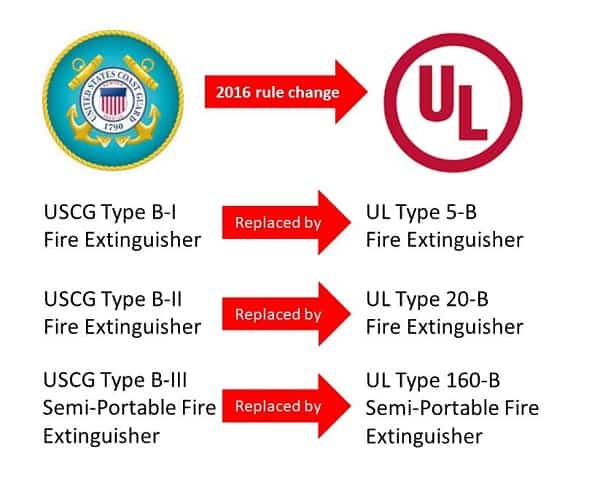
Can old fire extinguishers be “grandfathered?”
What if you still have fire extinguishers from before the 2016 rule change? Do you need to buy new ones? Probably not.
For one thing, pre-2016 USCG-approved extinguishers were likely also UL-listed. So there’s a very good chance that your old B-I extinguisher is also 5-B or larger in the UL system. Check the label for the UL symbol and size.
Plus, there’s a grandfather clause. CFR 46 § 25.30–80 states that too-small extinguishers installed before 2016 need not be replaced if they are kept in good condition “to the satisfaction of the Officer in Charge, Marine Inspection.” All newly installed extinguishers must follow the new UL standard.
How many fire extinguishers are required on a boat?
Determining the number of fire extinguishers you need and how big they should be depends on whether you have a motorboat or a motor vessel.
Per CFR 46 § 24.10–1, the difference between a motorboat and a motor vessel lies mainly in length. A motorboat is a machine-powered craft less than 65 feet in length, and a motor vessel is a machine-powered craft more than 65 feet in length.
Within the motorboat and motor vessel categories, the number of fire extinguishers required depends on how big your boat is and whether you have a fixed fire extinguishing system installed in the machinery space.
Number of extinguishers needed on motorboats
Most recreational boats are motorboats.
As mentioned previously, small (<26 ft.) motorboats with outboard motors that don’t carry passengers for hire and with low fire hazards aren’t required to have fire extinguishers at all—though it’s not a bad idea. If your boat doesn’t have those exceptions, Table 25.30-20(a)(1) in CFR lists the number of 5-B extinguishers you need:
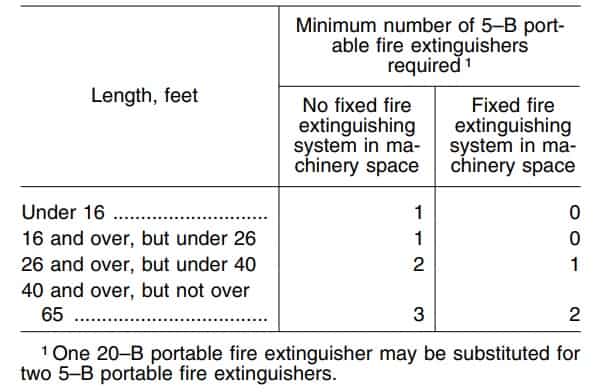
For a boat less than 26 feet in length, only 1 portable fire extinguisher is required. That number increases to 2 above 26 feet and 3 above 40 feet. If you have a fixed system such as a fire sprinkler system in the machinery space, you may reduce the number of required extinguishers by 1.
Number of fire extinguishers needed on motor vessels
Only really big boats are classified as motor vessels. Because these vessels have large engines and carry more fuel, more fire extinguishers are required. The number of extinguishers needed depends on two factors: weight (gross tonnage) and the size of the engine (BHP).
The standard size of a fire extinguisher for a motor vessel is 20-B, and every motor vessel needs at least 1. CFR’s Table 25.30–20(b)(1) lists the number of 20-B extinguishers required:
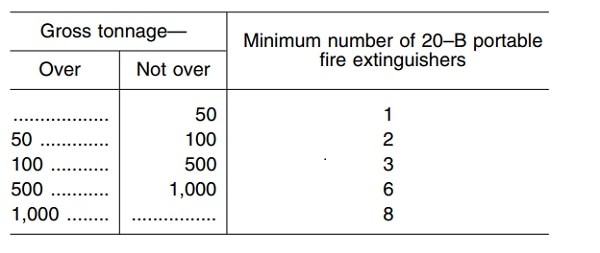
The large engines of large vessels need extra protection. On top of these rules, add another 20-B extinguisher for every 1,000 BHP of the vessel’s engine. All engines between 1 BHP and 1,000 BHP require 1 additional extinguisher. At 1001 BHP, 2 more extinguishers are added.
One more level of protection is required for very heavy boats. Any vessel over 300 gross tons must have either:
- One 160-B semi-portable fire extinguisher, or
- A fixed fire extinguishing system in the machinery room
Semi-portable fire extinguishers are large, heavy, and must be moved on wheeled dollies—a big inconvenience. A fixed fire extinguishing system provides extra safety, plus relieves you of the burden of storing and maintaining semi-portable fire extinguishers.
Where should fire extinguishers be stored on a boat?
The US Code of Federal Regulations actually makes no comment about where and how fire extinguishers should be stored on a boat. After all, it cites NFPA 10 (2010 edition), which provides all the essential information about fire extinguisher storage.
Let’s take a brief look at where and how fire extinguishers should be stored according to NFPA 10.
Boat fire extinguisher placement
NFPA 10’s requirements for the placement of fire extinguishers are all about ease of access—they should be “readily accessible and immediately available” (6.1.3.1) and “located along normal paths of travel” (6.1.3.1).
The core rule is that extinguishers should be located where they are easy to get to during a fire. This means putting them in places where people usually inhabit. If the visibility of fire extinguishers will be obstructed, their location should be clearly indicated (6.1.3.3.2), such as with a high-visibility decal.
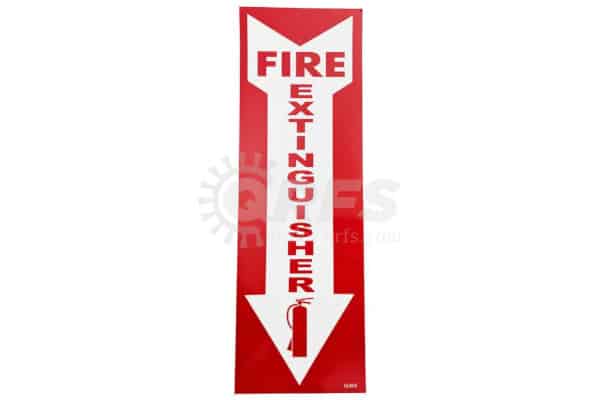
Beyond this, NFPA 10 has rules for the minimum walking distance to the nearest fire extinguisher based on the hazard level and the fire extinguisher’s size.
Table 6.3.1.1 in NFPA 10 lists these distances, but you don’t even need to consult the table unless you have a very large boat. Depending on the size of the fire extinguisher, it needs to be within 30 to 50 feet of any point on a vessel—not a problem for most recreational craft.
Fire extinguisher cabinets and brackets
Per NFPA 10 (6.1.3.4), all fire extinguishers have to be stored with a hanger made for the extinguisher, a listed bracket, or a cabinet or wall recess. Proper fire extinguisher storage is especially important at sea, where the boat’s motion on the waves can jostle equipment. NFPA 10 says:
6.1.3.6 Fire extinguishers installed in vehicles or under other conditions where they are subject to dislodgement shall be installed in approved strap-type brackets specifically designed for this application.
Strap brackets are probably the best choice for mounting and restraining fire extinguishers at sea.
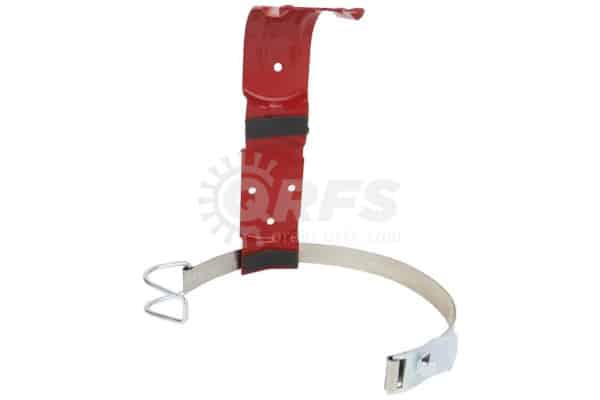
If you’re heading out on the water, know the requirements
Again, in 2016, the federal rules for fire extinguishers on boats changed. This has created some confusion because many websites still cite the old rules, and many vendors describe fire extinguishers based on outdated regulations.
Fortunately, the law change is very simple. UL fire extinguisher standards have replaced old Coast Guard standards. UL listed means Coast Guard-approved. Additionally, NFPA 10 was adopted as the primary standard governing the use, maintenance, and inspection of fire extinguishers.
Beyond these changes, you should know that:
- Type 5-B fire extinguishers replaced B-I extinguishers
- Type 20-B fire extinguishers replaced B-II extinguishers
- If you installed USCG-compliant B-I or B-II extinguishers before 2016, you can keep them even if they are too small, as long as they are well-maintained
For more information about fire extinguishers, check out our previous blogs on extinguishers classes, servicing, and use, fire extinguisher use in cars, problems that cause fire extinguishers to fail, and recharging fire extinguishers.
Need to purchase fire extinguishers and accessories to keep your boat Coast Guard-compliant? QRFS has the UL-listed (and therefore USCG-approved) ABC fire extinguishers you need, plus cabinets, brackets and hangers, and decals.
If you have questions or need help placing an order, call us at 888.361.6662 or email support@qrfs.com.
This blog was originally posted at blog.qrfs.com. If this article helped you, check us out at Facebook.com/QuickResponseFireSupply or on Twitter @QuickResponseFS.


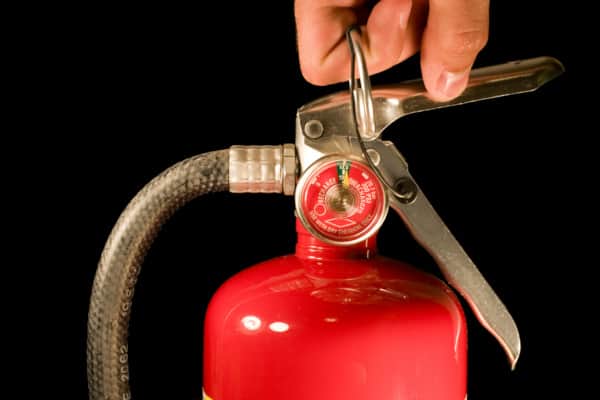
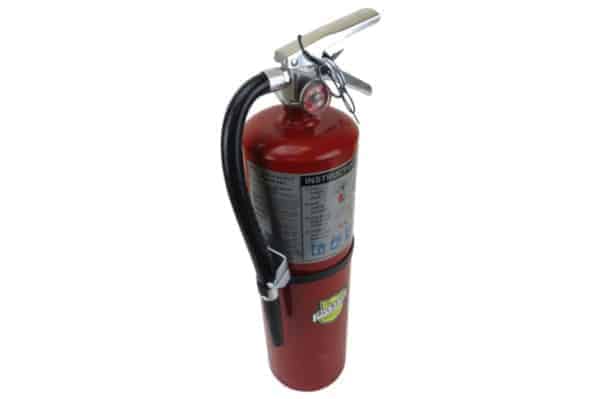
“The basics of inspection and maintenance for fire extinguishers on boats”
You left this part out of your article.
Rich — The basics of inspection largely revolve around making sure you have a sufficient number of approved extinguishers, placed appropriately (which the article covers). What it fails to cover is ensuring those extinguishers work. That topic is covered here, here, and here. Thanks for reading and pointing out that we can improve the piece!
Are there provisions for electric boats? I have a 16-foot catamaran with an electric outboard motor (6kW), which avoids the need for a fire extinguisher based on either length or the motor being outboard, but what of a larger boat (over 26 feet) with an inboard electric motor?
Bobkart — We are aware of fire extinguisher rules for electric boats offhand, but that doesn’t mean there aren’t any—and it’s a good question. Your best bet is to contact US Coast Guard Headquarters, as they specifically take recreational boating questions like this one. Thanks for reading!
If your boat is shorter than 26 feet, you should use one 5B fire extinguisher. By contrast, if it’s longer, you should equip one 20B fire extinguisher or two 5B types.
I run a charter headboat 50′. My halon system needs replacing,should I go back with url fixed ABC extinguishers? Engine room 12’x12′. And what extinguishers can I use coast guard approved?
Dave — Unfortunately, we can’t comment on the best options for your situation. One course of action may be to contact the US Coast Guard. Thanks for reading.